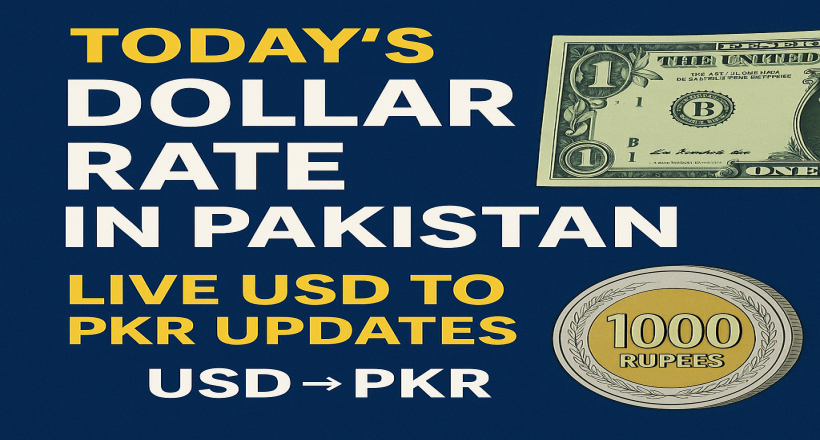We are using a merchant for PayPal and Stripe so in order to buy from their gateway you have to buy a minimum of 100 PKR equivalent.

Ever wonder why everyone in Pakistan keeps an eye on the dollar rate? Whether you're running a business, planning to study abroad, or simply buying groceries, the dollar rate plays a huge role in daily life. It's not just a number—it’s a pulse check on the economy.
The USD to PKR rate has seen wild swings in recent years. From hovering around PKR 100 per USD a few years back to soaring above 280 in 2025, it’s been a roller coaster. But why does it change so often? Let’s dig in.
Several forces shape the dollar rate:
When demand for the dollar increases—like during import booms or foreign debt repayments—the price goes up. Limited supply makes it more expensive.
Higher inflation weakens the rupee. Meanwhile, if the U.S. raises interest rates, investors flock to the dollar, boosting its value.
Uncertainty, poor governance, or a change in finance ministry can spark sharp reactions in the forex market.
The interbank rate is used by banks for large transactions. The open market rate is what you and I get at exchange dealers. And yes, they differ—sometimes a lot!
As of July 19, 2025, the USD to PKR is trading at approximately PKR 285.50 in the open market, while the interbank rate is around PKR 283.80. Rates can change multiple times a day, so staying updated is crucial.
SBP’s website publishes the official rate every working day.
Platforms like XE.com, Investing.com, and OANDA provide real-time data.
Apps like XE Currency, Forex.pk, and Pakistan Exchange offer live updates on the go.
Back in 2013, 1 USD = PKR 100. Fast forward to 2025, and we’re nearing PKR 290. This decline has been gradual but occasionally violent due to economic shocks and policy missteps.
IMF Bailouts
COVID-19 Pandemic
Ukraine-Russia War
Political instability post-2023 elections
Rising global interest rates
A strong dollar makes imports costlier—bad news for electronics and machinery buyers. But it helps exporters by making Pakistani goods cheaper abroad.
Oil is bought in dollars. When the dollar rises, petrol prices skyrocket—and so does inflation.
Imported steel, cement, and tiles become expensive, stalling construction projects.
When the dollar gains, overseas Pakistanis sending money home get more rupees per dollar. It’s a silver lining for many families.
Some analysts predict the dollar could breach PKR 300 by end of 2025 if current trends persist. Others expect stabilization due to expected foreign aid and reforms.
Experts at Bloomberg and The Economist warn of further devaluation unless fiscal reforms are adopted. Local analysts, however, are more optimistic due to expected inflows from China and Gulf countries.
Diversify your savings: Keep a mix of PKR and USD if possible.
Invest in gold or foreign mutual funds.
Avoid unnecessary foreign loans.
Businesses can hedge risks by:
Using forward contracts
Billing in local currencies
Reducing import dependency
SBP controls inflation, stabilizes the rupee, and maintains forex reserves. It can inject dollars into the market or tweak interest rates.
Tightening monetary policy
Restrictions on imports
Seeking foreign loans and remittances
Dollar up? Expect a flurry at money exchangers. Panic buying and hoarding become common.
Every news flash on the dollar triggers social media storms. Unfortunately, not all updates are accurate—verify before you panic.
XE Currency
Forex.pk
Pakistan Exchange Rates
Dawn Business
Business Recorder
Bloomberg Pakistan
Tracking the USD to PKR rate isn't just for economists—it's for everyone. From the price of your favorite snacks to your monthly rent, the dollar rate affects it all. With smart planning, awareness, and the right tools, you can stay one step ahead. So bookmark those live rate apps, follow credible sources, and keep an eye on the trends—your wallet will thank you!
1. How often do dollar rates change in Pakistan?
Dollar rates can change multiple times a day, especially in the open market. Always check real-time updates before making any currency exchange.
2. What is the best time to buy dollars in Pakistan?
Usually, rates are more stable in the morning. Avoid end-of-day fluctuations.
3. Why is there a difference between interbank and open market rates?
Interbank rates are for large-scale transactions between banks. Open market rates are for public exchange and include dealer margins.
4. Can I trade USD online in Pakistan?
Yes, through licensed platforms and banks. Always use registered and regulated services.
5. Is the dollar expected to rise or fall in 2025?
Experts predict a rise if reforms are delayed. However, foreign aid and remittances may help stabilize the rate.